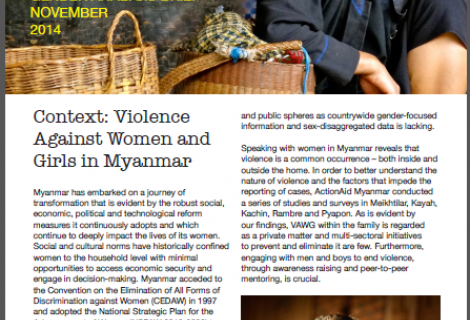
Gender Analysis Brief 2014: Violence Against Women and Girls & Access to Justice in Myanmar
Context: Violence Against women and Girl in Myanmar
Myanmar has embarked on a journey of transformation that is evident by the robust social, economic, political and technological reform measures it continuously adopts and whichcontinue to deeply impact the lives of its women.
Social and cultural norms have historically confined women to the household level with minimal opportunities to access economic security and engage in decision-making. Myanmar acceded to the Convention on the Elimination of All Forms of Discrimination against Women (CEDAW) in 1997 and adopted the National Strategic Plan for the Advancement of Women (NSPAW 2013-2022) to ensure that the Country’s women are empowered and able to fully enjoy their rights by ensuring that enabling systems, structures and practices are created.
However, the existing legal framework does not meet the needs of women vulnerable to, or survivors of violence. Furthermore, little is known of the prevalence and types of violence against women and girls (VAWG) encountered in private and public spheres as countrywide gender-focused information and sex-disaggregated data is lacking.
Speaking with women in Myanmar reveals that violence is a common occurrence – both inside and outside the home. In order to better understand the nature of violence and the factors that impede the reporting of cases, ActionAid Myanmar conducted a series of studies and surveys in Meikhtilar, Kayah, Kachin, Rambre and Pyapon. As is evident by our findings, VAWG within the family is regarded as a private matter and multi-sectoral initiatives to prevent and eliminate it are few. Furthermore, engaging with men and boys to end violence, through awareness raising and peer-to-peer mentoring, is crucial.
Section 1. Knowledge, Attitude and Practice (KAP)
Section 2. Gender Analysis: Engaging with men to end Violence against women and girls
Section 3. Services Providers: Prevention of and Response to cases of violences